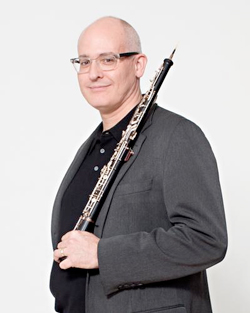by Nicholas Jones

Sunday afternoon:1 music stands waiting in the room
where carriage horses used to stomp,
now, modern art on the panelled walls
and chairs packed in, while through the window
magnolia flowers shed the April snow.
And now the music.2 First, the English horn3 meditates,
dark and melancholy, Hamlet-like,
anxious, passionate, and at last serene.4
And then, a music as if at sea:5 the horn is a boat
dancing on the trembling waves of strings.6
After intermission (wine, chocolate,
conversation), another musical journey,
a path through foggy mountains;
a festival in moonlight; a bagpipe
and some noisy birds, perhaps; and again, at the last, calm.7
At journey’s end, one long low note
drawn from the English horn, spun aloft, it seemed, forever:
circular breathing — finding air
even as the instrument asks for all you have —
a wondrous convergence of breath and will.
At the center of this circle of air,
a poet and musician: his double reed,
Pan’s legacy, and perhaps Apollo’s too:
the one speaks through his horn
and the other vibrates in the poet’s voice.8
His poems (and one by Billy Collins),
clear, committed, and consonant;
brimming with watery creatures, starfish,
swans, and other fluent forms; those that sing,
and those for whom silence is the only way to sing.9
Thanks for this acoustic artistry! poems,
strings, and English horn, unusual
convergences of beauty; thanks for composers,
hosts, presenters, poets, players, audience! —
those who make the notes, those who give them voice,
and those who shape the paths by which they sing.
1 Sunday afternoon: The concert, “The Sung Path: Poems and Music for the English Horn,” was given on Sunday, April 2, 2016, in a restored carriage house, and presented by Heights Arts, a multi-disciplinary Cleveland Heights arts advocacy group now in its tenth year.
2 And now the music: The concert featured three works for string ensemble and English horn: Jennifer Higdon’s Soliloquy, from 1989; Voyage, a world premiere composed by The Cleveland Orchestra’s assistant principal oboist Jeffrey Rathbun; and Morning Star, by Chicago-based composer Edward Niedermaier.
3 English horn: All three pieces were introduced by, and featured Robert Walters, principal English horn in The Cleveland Orchestra and Professor at the Oberlin Conservatory. The works by Rathbun and Niedermaier were written for Walters.
4 anxious, passionate, and then serene: Higdon’s finely crafted Soliloquy emphasized the elegiac nature of the English horn — as Walters noted: “slow, sad, and a bit desperate.” The dominant woodwind voice was beautifully supported by a string quartet (about which more below).
5 a music as if at sea: Rathbun’s Voyage, premiered at this concert, employs a largely tonal, modernist-inflected idiom, with echoes of late Romanticism. A lyrical sea-journey motif takes a “voyage” through three movements: “Waves,” full of undulant motion and oceanic excitement; “Refuge,” evoking not so much a place of repose as a fending-off of imminent alarums; and “Searunner” — percussive and assertive, as if a speedboat had suddenly charged through waves of Debussy.
6 trembling waves of strings: The violinists were Stephen Rose (Cleveland Orchestra principal second violin) and Jeffrey Zehngut (also Cleveland Orchestra); the violist was Michael Strauss (Oberlin Conservatory professor), the cellist was Charles Bernard (assistant principal, Cleveland Orchestra), and the bassist was Scott Dixon (Cleveland Orchestra). Walters recounted an anecdote about his mentor, longtime Cleveland Orchestra principal oboist John Mack, who advised Walters to take every opportunity to play with string players — who (even amateurs, in Mack’s opinion) always create a beautiful sonority. These players, of course, were no amateurs. What Walters quoted Mack about wind ensembles, in contrast, will not be repeated here, but it made a certain comparison with the noises of aquatic fowl.
7 at the last, calm: Niedermaier’s Morning Star is an ambitious piece written a few years ago when the composer was teaching at Oberlin. It shapes rich and exciting sonorities for the string quartet, creating a resonant foundation, which, over the course of the thirty or so minutes, gradually comes to blend with the contrasting timbre of the English horn. The young composer (who spoke about the piece before it was played) has a strong sense of musical development, and is adept at finding varied and structurally appropriate directions in which to take the tuneful motifs and ideas that he works with.
8 the poet’s voice: Robert Walters is a superb double reed player; he also holds an MFA in poetry and is a prolific poet. Walters read his poems, interspersed between the pieces of music, with affable clarity.
9 those for whom silence is the only way to sing: Walters’s poems brought to the music a number of themes: love (he read a well-known Billy Collins poem, Japan, about various intimacies, sonic and sexual); creativity (both musical — Beethoven — and obstetrical in honor of Walters’ daughter, about to be born when the poem was written, and now three years old); and silence (an unplayed cello; music as perceived by the deaf). Walters writes poems that are crafted and conversational, elegant and accessible, and just quirky enough to keep one on one’s metaphorical toes (imagine linking Helen Keller, Wallace Stevens, and Olivier Messiaen in a single poem!).

Published on ClevelandClassical.com April 5, 2016.
Click here for a printable copy of this article



